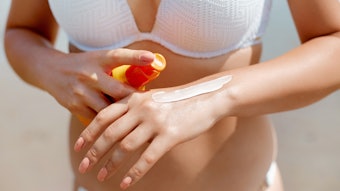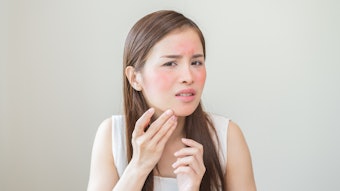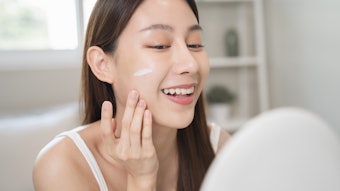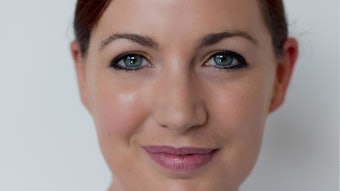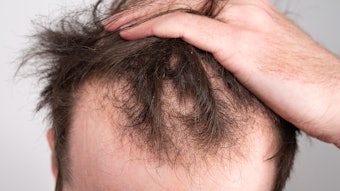Probiotics are living microorganisms. Consumers eat them in dairy products and value them for their health benefits. A companion article (see The Probiotic Nature of Normal Microflora on Page 41) discusses the role of probiotics and normal microflora in maintaining homeostasis in human intestines and on human skin and mucosa. This column discusses mechanisms by which probiotics provide therapeutic activity in the intestines, where most of the research has been done, and on the skin, where more research is needed.
One goal of this column is to point out that many of the identified actions of probiotics are already being performed by the normal microflora of skin and mucous membranes. A second goal is to suggest that formulators recognize opportunities for making products that modulate the normal microflora. This will help maintain the health and/or improve the appearance of skin and mucous membranes.
Figure 1a illustrates schematically how bacteria or toxins may interact with a cell. By attaching to a cell membrane receptor, they initiate a sequence of intracellular reactions that result in the release of nuclear factor kappa-beta (NF-κß) from its inactive form with its inhibitor (NF-κß-I) to produce the active molecule that migrates to the nucleus and directs synthesis of inflammatory cytokines (IL-1, TNFα, IL-8) and initiates apoptosis.
Figure 1b shows probiotic bacteria interacting with the cell to prevent the release of inflammatory cytokines and to down-regulate the inflammatory process by directing the cell to produce cytokines that decrease inflammation.
Probiotics in the Intestines
It must be realized that the mechanisms described here require a large number of probiotic microorganisms to be effective.
Blocking attachment sites and competing for food: The first step in infection is the attachment of a microorganism to a target cell. It has been believed for several decades that probiotics protect intestinal epithelial cells by competing with pathogens for mucosal adherence sites. Adherence by probiotics blocks pathogens from attaching to their target cells so they are stopped before they can initiate an infection.
Also, probiotic microorganisms are believed to compete with other microorganisms for nutrients in the gastrointestinal tract. This competition limits the ability of pathogens to grow.
Producing antimicrobial peptides: Probiotics may also stimulate epithelial cells to produce antimicrobial peptides such as defensins. The defensins are cationic peptides that are effective against Gram-positive and Gram-negative bacteria. Wehkamp et al.1 found that probiotic bacteria strongly induce the expression of human β-defensin-2 (hBD-2) in Caco-2 intestinal epithelial cells in a time- and dose-dependent manner. They found that treatment with a NF-κß inhibitor blocked hBD-2 induction.
Such stimulation of innate defenses through up-regulation of inducible antimicrobial peptides enhances the mucosal barrier to potentially harmful bacteria in the GI tract.
Cathelicidins are small cationic peptides that have broad specificity against bacteria, fungi, parasites and viruses. They are thought to kill bacteria by disruption of cell membrane integrity and/or block protein synthesis.
Nizet and Gallo2 reviewed cathelicidin antimicrobial peptides and their role in defense against invasive bacterial infection. Humans have a single human cathelicidin; it is known as LL-37 because it begins with two leucines and has 37 amino acid residues. Nizet and Gallo indicated that disregulated cathelicidin expression may contribute to chronic inflammatory disorders. Short-chain fatty acids have been reported to up-regulate colonocyte production of cathelicidin LL-37,3 so it is possible that lactic acid production by probiotic bacteria in the intestine may up-regulate production of cathelicidins by intestinal epithelial cells.
Modulating cellular physiology: Interaction of bacteria with epithelial cells can modulate cellular physiology. Drakes et al.4 studied probiotic modulation of dendritic cells and found that there was substantial enhancement of interleukin-10 (IL-10) release after three days of stimulation with bacterial probiotic cocktail VSL#3. IL-10 is a cytokine that down-regulates inflammatory responses, so this report helps to explain how probiotics work in situ to promote immunological quiescence.
Probiotics may inhibit phosphorylation of I-κß, the enzyme that releases NF-κß. Phosphorylation is needed to convert I-κß to the active form of the enzyme so it can cleave NF-κß-I and release NF-κß. Inhibition of the activation of this enzyme by probiotics prevents the production and release of inflammatory cytokines (IL-1, TNFα, IL-8), and it may induce the formation and release of non-inflammatory cytokines (e.g., IL-10) and heat shock proteins (hsps) that down-regulate cellular responses and reduce apoptosis.
Cross talk: Interactions between bacteria and cells with which they are associated are believed to be mediated by signal transduction within the host cell. Organisms designated as harmful or pathogenic cause inflammatory responses and infections (as illustrated in Figure 1a); probiotics decrease inflammatory reactions and stimulate host cells to produce antimicrobial peptides that help protect them from harmful microorganisms
(see Figure 1b).
This “cross talk” between bacteria and mammalian cells has been studied in detail for many different probiotic microorganisms because researchers are trying to understand the mechanisms by which they direct cellular activities.
Probiotics on the Skin
New developments in the field of intestinal microbiology are providing insights into the relationship of man and the microorganisms that comprise the normal microflora of the human intestinal tract.5 The normal microflora of the gut is a silent partner whose influence on the immune response is beginning to be appreciated. Similarities between the actions of probiotics and some members of the normal microflora of skin and mucous membranes suggests that both probiotics and the normal microflora are able to decrease inflammatory responses of the immune system (see companion article The Probiotic Nature of Normal Microflora). The following examples illustrate the use of probiotics to protect the skin and reduce inflammation.
Oral probiotics to protect skin after UV exposure: Guéniche et al.6 investigated whether oral probiotics were able to modulate the skin immune system (SIS) of hairless mice exposed to UV radiation (UVR). They found that feeding the animals Lactobacillus johnsonii at 108 cfu/day for 10 days was able to protect against UVR-induced suppression of contact hypersensitivity, decreased epidermal Langerhans cell density, and increased IL-10 serum levels. The probiotic bacteria had no detectable effect on the SIS without UV exposure, so their data support re-establishment of skin homeostasis following damage by UVR. These findings demonstrated that ingested probiotic bacteria work to maintain cutaneous immune capacity after UVR exposure.
Topical probiotics to reduce skin inflammation: Chapat et al.7 examined whether Lactobacillus casei affected antigen-specific T-cell-mediated skin inflammation. They found that daily administration of fermented milk containing L. casei, L. casei alone, or L. casei cell walls decreased skin inflammation because it inhibited the priming/expansion of hapten-specific IFN-Y-producing CD8+ effector T-cells. The down-regulatory effect of the probiotics required the presence of CD4+ T-cells, which control the size of the CD8+ T-cell pool primed by 2,4-dinitrofluorobenzene. These findings suggested that live L. casei and L. casei cell walls could reduce skin inflammation.
Topical probiotics to inhibit growth of microorganisms on the skin:
A Ganeden Biotech patent8 disclosed that topical compositions derived from an isolated Bacillus spp., spores, or an extracellular product (culture supernatant or filtrate) of Bacillus coagulans were used to inhibit the growth of bacteria, yeast, fungi, viruses and combinations thereof. In addition, their patent disclosed compositions of a supernatant or filtrate of a culture of Pseudomonas lindbergii for inhibiting the growth of bacteria, yeast, fungi, viruses, and combinations thereof. Findings such as these illustrate that microorganisms that are not lactic acid bacteria may have probiotic activity and be able to modulate growth of microorganisms on skin and mucous membranes.
Conclusion
There is exciting research in the field of intestinal microbiology that may provide insights into the relationship of man and the microorganisms that comprise the normal microflora of the intestinal tract. Research is showing that both probiotics and normal microflora appear to down-regulate the immune system in the intestinal tract and at other sites in the body. Recent articles and patents illustrate that the therapeutic benefits of probiotics are providing a model for future product development.
References
1. J Wehkamp et al, NF-kb- and AP-1-mediated induction of human beta defensin-2 in intestinal epithelial cells by Escherichia coli Nissle 19717: A novel effect of a probiotic bacterium, Infect Immun 10 5750–5758 (2004)
2. V Nizet and RL Gallo, Cathelicidins and innate defense against invasive bacterial infection, Scand J Infect Dis 35 670–676 (2003)
3. J Schauber et al, Expression of the cathelicidin LL-37 is modulated by short chain fatty acid in colonocytes: relevance of signaling pathways, Gut 52 735–741 (2003)
4. M Drakes, T Blanchard and S Czinn, Bacterial probiotic modulation of dendritic cells, Infect Immun 72 3299–3309 (2004)
5. DS Orth, New developments and opportunities in cosmetic microbiology, In Cosmetic and Drug Microbiology, DS Orth et al, eds, New York: Informa Healthcare 354–357 (2006)
6. A Guéniche, J Benyacoub, TM Buetler, H Smola and S Blum, Supplementation with oral probiotic bacteria maintains cutaneous immune homeostasis after UV exposure, European J Dermatol 16(5) 511–517 (2006)
7. L Chapat, K Chemin, B Dubois, R Bourdet-Sicard and D Kaiserlian, Lactobacillus casei reduces CD8+ T cell-mediated skin inflammation, Eur J Immunol 34 2520–2528 (2004)
8. US Pat 6905692, Topical compositions containing probiotic bacillus bacteria, spores, and extracellular products and uses thereof, S Farmer, assigned to Ganeden Biotech, USA (Jun 14, 2005)
